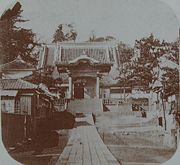
Zenpuku-ji
Encyclopedia


Jodo Shinshu
, also known as Shin Buddhism, is a school of Pure Land Buddhism. It was founded by the former Tendai Japanese monk Shinran. Today, Shin Buddhism is considered the most widely practiced branch of Buddhism in Japan.-Shinran :...
temple located in the Azabu
Azabu
is an area within Minato in Tokyo, Japan, built on a marshy area of foothills south of central Tokyo. Its coverage roughly corresponds to that of the former Azabu Ward, presently consisting of nine official districts: Azabu-Jūban, Azabudai, Azabu-Nagasakachō, Azabu-Mamianachō, Nishi-Azabu,...
district of Tokyo
Tokyo
, ; officially , is one of the 47 prefectures of Japan. Tokyo is the capital of Japan, the center of the Greater Tokyo Area, and the largest metropolitan area of Japan. It is the seat of the Japanese government and the Imperial Palace, and the home of the Japanese Imperial Family...
, Japan
Japan
Japan is an island nation in East Asia. Located in the Pacific Ocean, it lies to the east of the Sea of Japan, China, North Korea, South Korea and Russia, stretching from the Sea of Okhotsk in the north to the East China Sea and Taiwan in the south...
. It is one of the oldest Tokyo temples, after Asakusa
Asakusa
is a district in Taitō, Tokyo, Japan, most famous for the Sensō-ji, a Buddhist temple dedicated to the bodhisattva Kannon. There are several other temples in Asakusa, as well as various festivals.- History :...
.
Founded by Kūkai
Kukai
Kūkai , also known posthumously as , 774–835, was a Japanese monk, civil servant, scholar, poet, and artist, founder of the Shingon or "True Word" school of Buddhism. Shingon followers usually refer to him by the honorific titles of and ....
in 824, Zenpuku-ji was originally a Shingon
Shingon Buddhism
is one of the mainstream major schools of Japanese Buddhism and one of the few surviving Esoteric Buddhist lineages that started in the 3rd to 4th century CE that originally spread from India to China through traveling monks such as Vajrabodhi and Amoghavajra...
temple. Shinran
Shinran
was a Japanese Buddhist monk, who was born in Hino at the turbulent close of the Heian Period and lived during the Kamakura Period...
visited the temple during the Kamakura period
Kamakura period
The is a period of Japanese history that marks the governance by the Kamakura Shogunate, officially established in 1192 in Kamakura by the first shogun Minamoto no Yoritomo....
and brought the temple into the Jodo Shinshu
Jodo Shinshu
, also known as Shin Buddhism, is a school of Pure Land Buddhism. It was founded by the former Tendai Japanese monk Shinran. Today, Shin Buddhism is considered the most widely practiced branch of Buddhism in Japan.-Shinran :...
sect.
Under the 1859 Treaty of Amity and Commerce
Treaty of Amity and Commerce (United States-Japan)
The , also called Harris Treaty, between the United States and Japan was signed at the Ryōsen-ji in Shimoda on July 29, 1858. It opened the ports of Yokohama and four other Japanese cities to American trade and granted extraterritoriality to foreigners, among other stipulations.-The Treaty:The...
, the first Tokyo legation of the United States of America
United States
The United States of America is a federal constitutional republic comprising fifty states and a federal district...
was established at Zenpuku-ji under Consul-General Townsend Harris
Townsend Harris
Townsend Harris was a successful New York City merchant and minor politician, and the first United States Consul General to Japan...
.
Fukuzawa Yukichi
Fukuzawa Yukichi
was a Japanese author, writer, teacher, translator, entrepreneur and political theorist who founded Keio University. His ideas about government and social institutions made a lasting impression on a rapidly changing Japan during the Meiji Era...
, the founder of Keio University
Keio University
,abbreviated as Keio or Keidai , is a Japanese university located in Minato, Tokyo. It is known as the oldest institute of higher education in Japan. Founder Fukuzawa Yukichi originally established it as a school for Western studies in 1858 in Edo . It has eleven campuses in Tokyo and Kanagawa...
, is buried at the temple, and Keio staff and alumni visit the temple on February 3 of each year (the anniversary of his death).
See also
- For an explanation of terms concerning Japanese Buddhism, Japanese Buddhist art, and Japanese Buddhist temple architecture, see the Glossary of Japanese BuddhismGlossary of Japanese BuddhismThis is the glossary of Japanese Buddhism, including major terms the casual reader might find useful in understanding articles on the subject. Words followed by an asterisk are illustrated by an image in one of the photo galleries...
.

